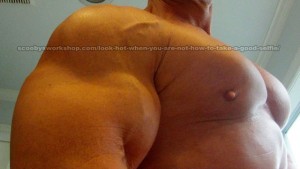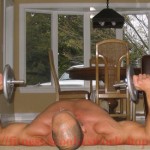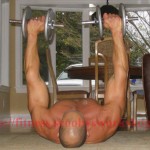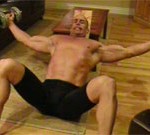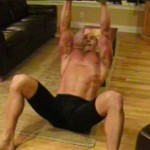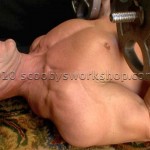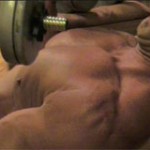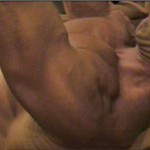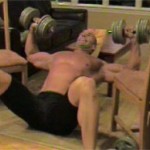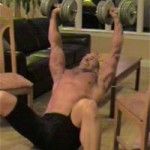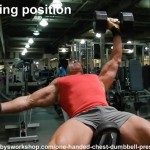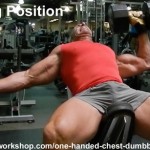Chest Exercises
Building massive pecs is often the first goal of bodybuilders. What do you need to buy? Although you can make great progress in strength and mass just buy doing pushups, dumbbells gives you a lot more exercise options. Please don’t waste money on new weights, you can get dumbbells used for pennies on the dollar from craigslist.
- Pec Building Basics
- Pushups (14)
- Dumbbell exercises
You can make your own chest workout by mixing and matching the above exercises, but unless you are really advanced, it’s better to use a well established workout plan. Please remember, lifting weights without maintaining proper nutrition is a waste of time! If you dont understand my nutrition section then consider the book Bodybuilding Revealed which has the best coverage of bodybuilding nutrition I have seen (Read my review).
Pec Building Basics
Many say I have over-developed pecs, what can I say – I guess that chest workouts are the one thing I have perfected! Its not that I work them out harder or more often than any other muscle group, I guess I just work them out smarter. Please also read the 10 secrets to huge pecs.
When trying to build a big chest, most beginners make the mistake of just doing bench press. Even non-bodybuilders know what bench press is from the movies so its natural that this is the first, and often the only, exercise that people do for chest. Just doing bench press for chest is bad because it really limits the size and strength of your pecs, pushing exercises (like bench press) are only half the story when it comes to chest gains. In my opinion, the squeezing chest exercises (like dumbbell flys) are even more important than the pushing chest exercises when it comes to mass and strength gains. I’m 50 years old and I haven’t done bench press in over two decades, hasn’t hurt my chest development any :) People always are interested in how much I can bench and I always answer – “Sorry, no idea but I do flys with 105lb dumbbells”. To maximize your chest development, you need to do both pushing exercises and squeezing exercises – neglect either and you limit your potential for mass and strength. From personal experience I have found that a 50/50 split of pushing and squeezing exercises provides optimal results. I have also found that alternating between pushing and squeezing exercises during the workout maximizes results.
I seem to be the only one who doesnt like doing bench press and incline press, so when you do them, please use good form. This video on bench, incline and military press explains how with bad form , a incline press unintentionally becomes a bench press and a military press can become an incline press.
Another mistake people commonly make is they try to specialize, they want to work “inner pecs” or upper pecs. No!! Big mistake! Unless you have been consistently for more than 5 years you need to stick to a good, well established workout plan without ‘improving’ it. You need an all-around pec workout that has you pushing and pulling from all angles. You can’t work inner pecs anyway! Genetics play a huge role in the shape of your pecs, some people have square pecs, others round ones. Some people have a big gap between their pecs, some have a triangular gap, and the lucky ones have no gap at all. Its genetics, there is nothing you can do about it. Just do give 110% to all the chest exercises and then all people will notice is you massive pecs, not the gap between them :)
Please remember, working out without maintaining proper nutrition will drastically limit your results. If you dont have the time to become an expert on bodybuilding nutrition, then consider using my awesome free custom meal planner. In under 90 seconds you can set up an account and make a complete meal plan to perfectly fit YOUR metabolic rate, YOUR nutritional preferences, and YOUR goals! Bulk, cut, or recomp using keto, low carb, medium carb, vegan, or vegetarian – your choice! All will result in an optimal meal plan, not only that, it will make you a shopping list and tell you how to prepare the meals!
Pushups
If I could only do two exercises for my upper body, it would be pushups and pullups – the bench press wouldn’t even make my top 10 list. Pushups are awesome for beginners and advanced bodybuilders alike. There are infinite variations that can make the pushups as easy or as challenging as you like. The form used for doing all pushups is the same, lets cover that first. We will be doing the pushups from our fists, pushup stands, or octagonal dumbbells – but NOT our palms. Doing them on your palms will result in wrist injury, don’t do it! Second, its very important that you hold your torso rigid and straight like a plank, flex your abs to do this. Watch yourself in a mirror or have a buddy watch you, most people make the mistake of sagging as they get tired. Next form item is speed, most people do the pushups way too fast in an effort to eek out more reps with horrible form – don’t do it. One to two seconds to go up and one to two seconds to go down – that’s a long time! Toward the end of your workout you will get very tired, don’t let your form suffer. Your pectorals are a big muscle group and take a hard workout to make them grow but don’t sacrifice form. You will get a more amazing pec pump from doing these simple pushups than you will from a heavy bench press. The pushups here are listed from easiest to hardest.
Proper Form:
Easy pushups:
Medium difficulty pushups:
Medium difficulty pushups:
Medium difficulty pushups:
Very difficult pushups:
Very difficult pushups:
Very difficult pushups:
Very difficult – Punching Pushup:
Very difficult – Ball Pushup:
Very difficult – Rolling Ball:
Very difficult – Assisted One Hand Pushup:
Very difficult – Baby Clap Pushups:
Chest Exercises Using Dumbbells
Dumbbell Flys
The dumbbell fly is one of my favorite exercises and is what I feel has given me my chest size. If you do flys on a bench, you need a spotter and need to make 100% sure that you don’t let your elbows drop lower than your shoulders as this would hyperextend your shoulder and put it at risk of injury. Like all exercises, the key is to do this exercise very slowly and with strict form – no cheating. Keep your arms straight but not locked, if you have to bend your elbows then use a lighter weight. Bend your knees and put your feet flat on the ground, this puts your lower back in a safe position. When lifting, flex your abs for additional lower back support. Form is everything, try for 2s up and 2s down. It is best to do dumbbell fly laying on the floor to safely limit your range of motion. To learn more about doing heavy chest exercises safely without a spotter, watch this video on self-spotting techniques for chest.
starting position: Arms nearly straight but elbows are not locked, palms are up. Hold your shoulders down and back, pretend you are squeezing a tennis ball between your shoulder blades thru the whole exercise. Slowly squeeze the weights up while breathing normally. Raising the weights should take about two seconds.
ending position: Arms still nearly straight. Now lower weights slowly back to starting position while breathing normally. Much of the benefit in this exercise comes from the negative portion (lowering the weight to the ground) so don’t deprive yourself of its benefits by mushing thru it. Resist gravity! Try and lower the weights as slowly as you can. Tremble and shake, swear and grunt but don’t let those weights down fast. Try and take at least 3 seconds to lower the weight (count out loud “one-one-thousand, two-one-thousand, three-one-thousand”). If you cant lower the weights that slowly then you should consider using a lighter weight.
Flat Dumbbell Press
The dumbbell press works the chest very similarly to the pushup, the advantage of dumbbell press is that you can use precisely the weight you need to challenge yourself. If you are a beginning bodybuilder then you may not have the strength yet to do pushups, by using light dumbbells you can provide just enough resistance to allow you to slowly build up strength so that you eventually be able to do pushups. Conversely, if you are an advanced bodybuilder, basic pushups are not much of a challenge. Dumbbell press for the advanced bodybuilder allows the use of weights far in excess of bodyweight so that the muscles can be sufficiently challenged to grow.
If you do dumbbell press using a bench, you need a spotter and need to make 100% sure that you don’t let your elbows drop lower than your shoulders as this would hyperextend your shoulder and put it at risk of injury. I strongly recommend that you do dumbbell press on the floor rather than on a bench for two important safety reasons. First, if you get into trouble and the weights come crashing down, your shoulders are protected because the weights will hit the floor before your shoulders hyperextend. Second, the floor safely limits your range of motion and doesn’t allow your elbows to drop behind the plane of your back. Many people get injured jerking heavy dumbbells into the starting position, on the floor this is a simple matter. Use a stack of big books like encyclopedias to set the dumbbells on, the weight causes the books to sag into a trough so that the dumbbells will not roll off. Use enough books so the handles are about a foot above the ground. Its then an easy matter to roll the dumbbells into the starting position. To hear more about doing heavy chest exercises safely without a spotter, watch this video on self-spotting techniques for chest. For those people who insist that they need more of a range of motion (I disagree), you can lay on a 2×10 on the floor which will give you another 1.5″ of range but still maintain the other advantages of doing the dumbbell press on the floor.
Starting Position. Upper arms are inline with each other, elbows are 90 degrees. Hold your shoulders down and back, pretend you are squeezing a tennis ball between your shoulder blades thru the whole exercise. Push up slowly while breathing normally, should take a count of two to get the weights up. While pushing the weights up, you are using two motions which combine for a maximum lift. First, obviously you are pushing, that is obvious to everyone. What is not obvious is that you also need to try to squeeze the weight up. What do I mean by squeezing the weight up? Grab a basketball and hold it about 2′ away from your body at shoulder level (elbows slightly bent) and try to pop the ball by squeezing it. Squeeze the ball repeatedly while watching yourself in the mirror until you get the feel for that. When you get the hang of that, pretend you are a mime, put the ball away, and pretend you are squeezing the imaginary ball. Your muscles should tense up just as they did when you were squeezing the ball. When you have mastered that, you can easily apply that to your dumbbell press and squeeze the weight up. When you are doing the dumbbell press you are pushing and trying to pop that basketball.
Ending Position. OK, we have squeezed and pushed the weight slowly up till the weights are over our head. We will NOT clank the weights, its annoying and you can get metal chips in your eyes. Most people just get excited about the pushing portion of this exercise and rush thru the negative portion which deprives them of much of the benefit of this exercise. Pressing the weights up looks impressive but much of the gains occur in the negative portion of the exercise, that is, when you are lowering them to the floor. We want to make this negative portion as agonizing as possible – remember, no pain, no gain. First, we want to lower the weights very slowly. How slowly? Say out loud “One-one-thousand, two-one-thousand, three-one-thousand” – that’s how long it should take you to lower the weights. If you cant lower them that slowly then you are using too much weight. As with pushing the weight up, we are focusing on two things while we are lowering the weights – pushing and squeezing. Work hard on the squeezing.
The negative portion of the exercise is SO important that many people use techniques which emphasize it. For example, if you have a spotter you can use a weight 10% higher than you can lift and have the spotter help you get the weights up and then lower them slowly (and agonizingly) under your own power. Don’t cheat yourself, emphasize the negative! (click on thumbnail for larger view)
Chicken Press
The chicken press is almost identical to the flat dumbbell press, the only difference is that the elbows are closer to the body. In a dumbbell flat press your upper arms point out 90 degrees from your body. In a hip press, your elbows brush your sides. In this chicken press, your elbows are half way between – kind of the position your elbows were in if you stuck your thumbs in your armpits and pretended to squawk like a chicken.
Starting Position. Upper arms not directly out to the sides, nor are they right at your sides – they are half way inbetween. Hold your shoulders down and back, pretend you are squeezing a tennis ball between your shoulder blades thru the whole exercise. Push up slowly while breathing normally, should take a count of two to get the weights up. While pushing the weights up, you are using two motions which combine for a maximum lift. First, obviously you are pushing, that is obvious to everyone. What is not obvious is that you also need to try to squeeze the weight up. What do I mean by squeezing the weight up? Grab a basketball and hold it about 2′ away from your body at shoulder level (elbows slightly bent) and try to pop the ball by squeezing it. Squeeze the ball repeatedly while watching yourself in the mirror until you get the feel for that. When you get the hang of that, pretend you are a mime, put the ball away, and pretend you are squeezing the imaginary ball. Your muscles should tense up just as they did when you were squeezing the ball. When you have mastered that, you can easily apply that to your dumbbell press and squeeze the weight up. When you are doing the dumbbell press you are pushing and trying to pop that basketball.
Ending Position. OK, we have squeezed and pushed the weight slowly up till the weights are over our head. We will NOT clank the weights, its annoying and you can get metal chips in your eyes. Most people just get excited about the pushing portion of this exercise and rush thru the negative portion which deprives them of much of the benefit of this exercise. Pressing the weights up looks impressive but much of the gains occur in the negative portion of the exercise, that is, when you are lowering them to the floor. We want to make this negative portion as agonizing as possible – remember, no pain, no gain. First, we want to lower the weights very slowly. How slowly? Say out loud “One-one-thousand, two-one-thousand, three-one-thousand” – that’s how long it should take you to lower the weights. If you cant lower them that slowly then you are using too much weight. As with pushing the weight up, we are focusing on two things while we are lowering the weights – pushing and squeezing. Work hard on the squeezing.
The negative portion of the exercise is SO important that many people use techniques which emphasize it. For example, if you have a spotter you can use a weight 10% higher than you can lift and have the spotter help you get the weights up and then lower them slowly (and agonizingly) under your own power. Don’t cheat yourself, emphasize the negative! (click on thumbnail for larger view)
Dumbbell Incline Fly
You know I love the dumbbell fly for building chest mass so here is another variant which you do on an incline bench, or board as I am here. For this incline fly use approximately 60% of what you use on the flat dumbbell fly. The palms are facing upward.
Starting Position. Hold your shoulders down and back, pretend you are squeezing a tennis ball between your shoulder blades thru the whole exercise. Arms nearly straight but elbows are not locked, palms are up. Slowly squeeze the weights up while exhaling.
Ending Position. Arms still nearly straight. Now lower weights slowly back to starting position while inhaling. Make sure not to let your elbows go behind the plane of your body as this is very hard on your shoulders and provides no additional benefit.
Dumbbell Hip Press
Two reasons I love this exercise, first is that is works the chest like no other exercise. Where I feel it is across the top of the pec, the part you want to build so you can set cups of coffee on top of your chest. But the more important reason I like the hip dumbbell press is because its shoulder friendly. For several types of shoulder problems, this is the only chest exercise you can do without causing pain or damage. So if bench press and ordinary dumbbell presses hurt your shoulder, give this one a try. Do this on the floor as I am and not on a bench because it properly limits your range of motion to protect your shoulder. On a bench, the temptation is to let your elbows go too far down.
Starting position: OK, Knees bent to protect the lower back. Put your shoulders down and back – squeeze the shoulder blades together like you are trying to hold a tennis ball between them. It takes a bit of practice but keep the shoulder blades together the whole time. Make sure to keep your elbows tight against your body, if your elbows wander outward its a clear sign you are using too much weight. Your elbows should touching sides when at the bottom of the movement.
Ending position: As you push the weights upward, dont let your elbows drift apart – keep them close together. Push slowly and smoothly trying to take 2 complete seconds to get up. Remember to keep the shoulders down and back during the whole movement. Dont twist the dumbbells as you go up, keep your thumbs pointed toward your head.
Dumbbell Incline Front Press
The incline front press is the incline version of the hip dumbbell press. In this exercise the elbows stay very close to your body as they do in a hip press. If you have an incline bench, that’s great. I make one by tying a 2×8 to my coffee table, it works great and I don’t have to store a huge bench. If you do this, make very sure that everything is completely secure and will not move while you are doing your exercise.
Starting Position. Knees bent, abs flexed, shoulders back and down like you are squeezing a tennis ball between your shoulder blades, elbows touching your sides lightly. Hold the dumbbells like ski poles. Before starting to push the dumbbells up, look how far apart they are – this is how far apart they should be at the top of the movement. Push up slowly while exhaling, should take a count of three to get the weights up. Flex your pecs on the way up, feel it!
Ending Position. As you push up, make sure your elbows stay close together, dont let them wander apart and turn this into an incline press. Remember the weights should be the same distance apart at the top of the movement as at the bottom. Remember to keep that tennis ball squeezed between your shoulder blades the whole pushup. At the top of the movement go until your arms are straight but not locked. The dumbbells should be directly over the spot where they were at the bottom of the movement. Now lower slowly back to starting position while inhaling, it should take a count of three to get back down. As you go down, stop when your elbows are at your side – dont let them drop behind your back as that can really mess up your shoulders.
Dumbbell Incline Press
The incline dumbbell press is a simple variant of the dumbbell press. If you have an incline bench, that’s great. I make one by tying a 2×8 to my coffee table, it works great and I don’t have to store a huge bench. If you do this, make very sure that everything is completely secure and will not move while you are doing your exercise. As with the dumbbell press, make 100% sure that you don’t let your elbows drop lower than your shoulders as this would hyperextend your shoulder and put it at risk of injury. You either need spotter(s) on this exercise or you need a self spotting rig to safely lift heavy weights.
Starting Position. Knees bent, abs flexed, shoulders back and down like you are squeezing a tennis ball between your shoulder blades, upper arms are inline with each other, elbows are 90 degrees. Push up slowly while exhaling, should take a count of three to get the weights up. Think about flexing your pecs on the way up, it helps focus.
Ending Position. Now lower slowly back to starting position while inhaling, it should take a count of three to get back down.
One Handed Incline Press
This is my current favorite exercise! Its a one arm press. Its obviously a chest exercise but what is not so obvious is that its the most incredible core workout you will ever get. Your first question is probably WHY? Why on earth would you bother to do a chest exercise with just one hand? It takes twice as long, right? Why not just do the basic dumbbell press. Great question! The answer is, if you have the luxury of endless amounts of gym time the basic shoulder press is fine. As I mentioned last month, at the end of the year I will be giving you a workout plan that gives you maximum results with minimum amount of gym time and what that means is that every exercise has to be triple duty. A lot of the exercises I am showing you this year do several things at once to save time. In this case we are obviously working the pecs but not so obvious is that we are working core – dont think so? Try it! The asymmetric load forces your core into action to keep you from crumpling an flipping over like a wet spaghetti noodle.
You can do this on the flat or incline, on a bench or a bosu ball, the basics are the same. First, you need to spread your feet out wide to keep from falling over. Getting a heavy weight into position safely is best done like this. Grab the dumbbell with the hand that will be doing the lifting and then wrap your other hand around it. Now you can do a two handed lift into position and slowly remove the assist hand as you figure out your balance.
Some Cautions!
The last thing you want to do is cause a muscle tear in the rib area – not much as painful as that so you want to build up to your max lift over a few months to give your core time to strengthen. When you get to your max 8 rep weight you will find that because of the core tension it will be very difficult to breathe deeply, thats ok. Just rest and catch your breath before doing the other side. A good place to start is 50%. If you can do the incline press with 100 pound dumbbells in each hand then start the one handed ones with 50 pounds and slowly work up over the next few months.
You have noticed lately that I have been showing you a lot of rather weird exercises – they are not weird just for the sake of being weird. As I mentioned before, later this year I am going to be showing you a workout plan that can get you the same results in 1/3 the gym time and to do that, every exercise has to do double or triple duty. My life now is too busy to do traditional workouts. As much as I LOVE doing one exercise at a time and lifting really heavy weights with 1-2 minutes rest between sets – its simply a time luxury I just cant afford.
A more impressive chest in 5 minutes
Before you are too hard on yourself about the size of your pecs, realize that when you look at pictures of others, myself included, camera angles are optimized to make the photos as impressive as possible. Please read “how to take a good selfie” and make your chest look more impressive with just a few simple photo tips.
